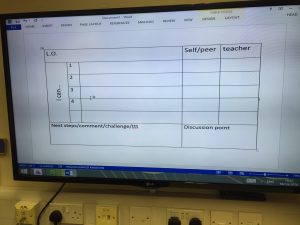OK…part 3 of the #nomarkingchallenge blog series…makes more sense (if only a little) if you read part 1 followed by part 2.
The trial at school over the spring and summer term in Year 3 went really well, with some better-than-expected progress, especially in the middle-ability group of children. This was possibly because this group suddenly had much more individual input from an adult. We think that’s what had the impact anyway.
As mentioned previously, the approach relies on focused learning objectives and tight success criteria. We use a table, which children stick in their books, which includes L.O.; success criteria; peer/self assessment tick boxes; teacher tick boxes; and next steps/challenge/discussion area. Sounds like a lot, but really isn’t! The one below is one we were tweaking in a recent staff meeting. This, aligned with dot marking, challenge marking* and next steps marking is the basis of all our feedback in English and Maths. It’s nothing earth-shattering, or particularly innovative, or radical in its approach.
A simple A4 sheet is used by staff to record any specific next steps for children that they might need the next day and this obviously informs planning. Planning – ah, that’s where we’re off next. I’ll let you know how we get on with that one too.
What I’ve loved about this is the fact that staff have embraced the approach, although some will admit to finding it difficult to get used to, and are constantly coming up with new ways to develop the approach to make it work even more effectively. We have come a long way since first discussing the idea, and I am convinced that this is a much better way of giving effective feedback than any triple-marking, funny-coloured-highlighting-codes-thingy, dialogic (I didn’t even know what that was until earlier) marking strategy. And it gives our staff a much, much better work-life balance than before. And that’s worth it on it’s own.




Hi,
I am really interested in this approach to marking. It is something we are working towards as a school, infact our WALT / LO sheet looks remarkably similar to yours from above. I wondered though what would be an example of the type of comments that went into the discussion point box?
Thanks in advance